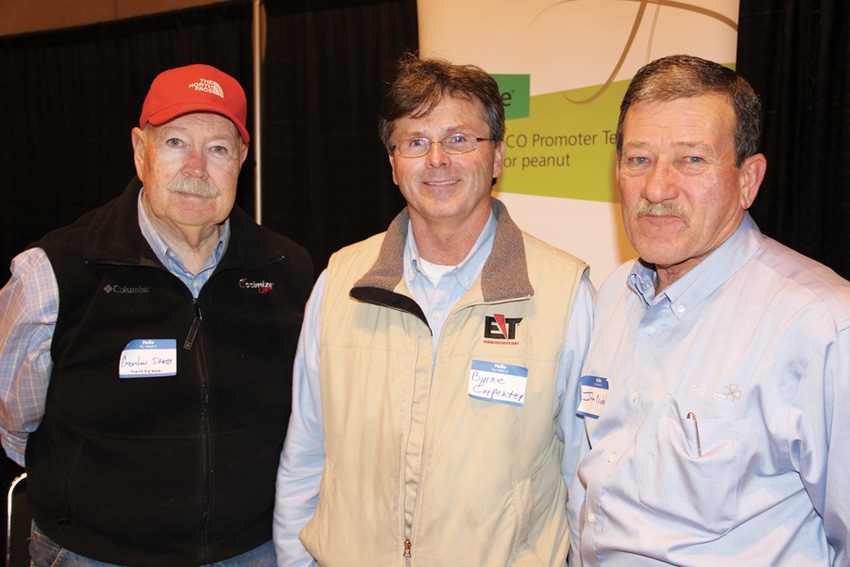
Wild hogs a rapidly multiplying menace for agriculture
“Wild hogs are eating machines — they’ll eat anything they can get their mouth on, whether it’s soybeans, peanuts, corn, watermelons, rabbits, snakes, stuff in your garbage can, you name it,” says Bronson Strickland of Mississippi State University.

From Mississippi crop fields, to the Vicksburg National Military Park and the Mississippi River levee, to the historic Natchez Trace Parkway, golf courses, and even many suburban home areas, wild hogs are bringing their own unique mode of destruction.

BRONSON STRICKLAND
“They’re eating machines — they’ll eat anything they can get their mouth on, whether it’s soybeans, peanuts, corn, watermelons, rabbits, snakes, stuff in your garbage can, you name it,” says Bronson Strickland, Mississippi State University associate Extension professor of wildlife, fisheries, and aquaculture and associate director for Extension and outreach of the Center for Resolving Human-Wildlife Conflicts. Since 2007, he has been working with Extension Agents and landowners to control wild pig populations in Mississippi.
“These animals can exploit almost any ecosystem,” he says. “They can live anywhere, from snowy northern regions to beaches to woods to semi-arid climates. There is no place in Mississippi they can’t colonize; as long as they’re within a day’s reach of water, they can thrive.”
And talk about multiplication: they’ve got rabbits beat by a mile, and even deer, which some wildlife specialists say now outnumber cattle in Mississippi.
“One pregnant sow can multiply to 40 hogs in five years, in 10 years 605, and in 20 years, 122,000 — that’s the concept of compound interest in living, eating, destructive form,” Strickland said at the annual conference of the Mississippi Peanut Growers Association.
In reality, he says, that much population growth is not sustainable, “because there would be so many hogs they’d be eating everything in sight.”
Still, the reproductive potential of the animals is so staggering, he says, that unless constructive steps are taken to corral their explosive growth and spread, “We’re going to be in for real trouble down the road.”
Ag news delivered daily to your inbox: Subscribe to Delta Farm Press Daily.
Today, Strickland says, about 40 percent of Mississippi’s land area is populated by wild hogs, and that’s expanding at about half a million acres per year. The only area of the state less affected is the Delta, due to less cover.
In an effort to stem the tide of foraging piggies, the Mississippi House of Representatives recently passed a bill, 107 to 6, to prohibit the transportation of wild hogs, a practice Strickland says has been a major contributor to their spread. The measure has the support of the politically powerful Mississippi Farm Bureau Federation.
A culture of hunting hogs
Unfortunately, he says, in the last few years there has developed a culture surrounding the hunting of wild hogs. “It’s growing in popularity, with business enterprises now making money letting people shoot wild hogs. In Texas, you can even hunt wild hogs from helicopters at something like $1,000 per hour. And there are TV programs about wild hogs.
“Shooting hogs has been growing in popularity in the U.S. over the last decade, and these animals are now the second most harvested species. In some states, Louisiana for one, deer hunters now harvest 10,000 to 12,000 more hogs than deer each year.”

“WE'D NEED TO HARVEST 50 percent to 70 percent each year, and that’s virtually impossible with recreational hunting," says Bronson Strickland. — Photo: Billy Higginbotham, Texas AgriLife Extension Service
But, Strickland says, hunting alone won’t effectively curb their population growth. “We’d need to harvest 50 percent to 70 percent each year, and that’s virtually impossible with recreational hunting.”
In the 1990s, he says, even though Tennessee permitted wild hogs to be killed anytime, anywhere, “populations increased even more and expanded their range.”
The No. 1 cause of expansion in the Southeast over the past 20 years, he says, has been people deliberately moving wild hogs from place to place to establish them for hunting. And inevitably, populations mushroom. More recently, in the Midwest and Northeast, where they were not naturally colonized, there are now growing populations that were started by people trapping them elsewhere and moving them in.
“We’re never going to make headway on stemming this population growth until this transportation is stopped,” Strickland says. “We need to enact stiff penalties for transporting, and in some areas to even consider making hunting illegal. That sounds counter-intuitive, but it has worked in some areas. Kansas and Nebraska have made hunting illegal, thus taking away any incentive to move hogs into those states.”
Collaboration among landowners and state agencies is also important, he says.
Today’s wild hog problem has its roots in two long-ago occurrences, Strickland says. The first goes all the way back to 1539, when Hernando Desoto brought along hogs on his explorations in the new world. They served as a food source and some were turned loose to colonize populations that future exploration teams could slaughter.
In 1912, a landowner in western North Carolina started a hunting preserve and stocked it with imported wild Russian boars. Though he’d constructed supposedly game-proof fences, some of the hogs eventually escaped and hybridized with domestic swine, which at that time were allowed to free-range.
“From this event, the Smoky Mountain wild hog population was started,” Strickland says. “Over decades, there were secondary introductions that have ranged all the way to Pennsylvania to Florida, and across the Sunbelt to California.
Hybridized with domestic hogs
“In Mississippi now, we have every combination possible of the Eurasian and Russian wild boars that have hybridized with domestic hogs that have been turned loose or escaped. Most are feral hogs.”
He compares the growth of the hog population in the state to that of deer, the latter which had its beginnings in a deliberate effort to increase numbers.
“In the 1940s and 1950s, there were very few deer in Mississippi and much of the Southeast. It was a big deal to even see a deer. A restocking effort was undertaken by our state natural resources agencies, and about 3,000 deer were initially turned loose and protected from hunting.
“Today, many people think we have too many deer, and they’re eating petunias in urban backyards and causing thousands of vehicle accidents each year.
“We’re seeing much the same situation with wild hogs. Their populations have grown throughout the state, to the point we’re now seeing them not just in fields and forests, but in the urban environment. In cities and towns, they’re turning over garbage cans and rooting around in yards.
SCARY MATH: 3x20=200,000 wild hogs, a growing threat for Mississippi farms
“They’re doing tremendous damage to crops, often with complete destruction of peanuts, corn, and a lot of other corps, including rice, watermelons, and even young forest seedlings.”
Scientists first started to study wild hog populations in 1988, surveying their impact on agriculture and domestic livestock and wildlife populations. “By 2009, numbers had mushroomed, and there was rapid spread and colonization,” Strickland says.
“That was the time action should have been taken to stem this tide, when only about 3 percent of the land area of these states was populated by wild hogs,” Strickland says. “At that point, we could probably have stopped the growth. But unfortunately, as has been the case with many invasive species, control programs weren’t instituted.”
Using data from the past 20 years and projecting 20 years forward, the wild hog picture could get downright scary, he says.
“It’s the most prolific large mammal in the U.S. They are sexually mature earlier than deer; they can have two litters every 15 months, with 4 to 6 piglets per litter surviving to one year of age. They have the capacity to double in number each year.
An opportunisic omnivore/carnivore
“If you were to write down a recipe for the success of an invasive species, wild hogs have it all: Diet — they will eat almost anything. Habitat — they can live almost anywhere. Reproductive rate — extremely high. Mortality — their only predator is humans. Occasionally, an alligator or a coyote will get one, but that’s a drop in the bucket.

WILD HOGS can do extensive damage to crops, as in this field where they rooted up corn seed that had been planted. — Photo: Trey Cooke
“It’s an opportunistic omnivore. Its diet is about 90 percent vegetation, including many of our Mississippi crops, and native vegetation. It is also an opportunistic carnivore, eating salamanders, frogs, rabbits — anything it can get its mouth on is subject to being eaten. It consumes 3 percent to 5 percent of its body weight each day, whether from crops, wildlife, or urban garbage cans. For your crops, that’s from day 1 across your entire crop growing season — the damage can be significant.”
Wild hogs also carry diseases, Strickland says. Pseudorabies and swine brucellosis are just two examples. Several diseases can be transmitted to native wildlife, domestic livestock, and even to humans.
“They compete with our desirable wildlife for food and habitat. In the fall, they have a 50 percent diet overlap with deer. If you have a deer conservation program and there are a lot of wild hogs on your land, the deer are losing — half their food is going into the hogs’ mouths. They will also kill a wide cross-section of wildlife, including fawns, turkey poults, qual, snakes, rabbits, etc., when they can catch them.
“Nationally, it’s estimated they do $1.5 billion damage yearly to crops, livestock, forests, and the ecology, including water contamination, but not including disease outbreaks.”
What can be done?
“Toxicants are the only control method that show any promise, Strickland says. “These are very effective — but currently, they are not legal. There are still unresolved questions of how to deliver them to hogs only, without impacting non-target wildlife, what is the proper dose that will be lethal to them, but not to scavengers.”
While contraceptives are sometimes suggested, “They are not an option,” he says. “They require multiple doses to be effective, and there is a potential health impact if humans eat the meat.”
Until a toxicant may be approved, he says, trapping is the best single method of control for landowners.
“We have some great informational resources, and we conduct all-day workshops that include information on trapping.
“The thing is, you have to take this very seriously. If you have hogs on your property now, you’re already behind the curve. If your neighbor has hogs, you’d better work with him to control them, or you’ll have them too.
“You don’t want to get into a situation where eradication becomes impossible, as has happened in most of Texas. The longer we let this go, the more difficult is going to be to ever get them under control.
Online resources are available at www.wildpiginfo.com, where you can download the publication, “A Landowner's Guide for Wild Pig Management: Practical Methods for Wild Pig Control.”
About the Author(s)
You May Also Like



